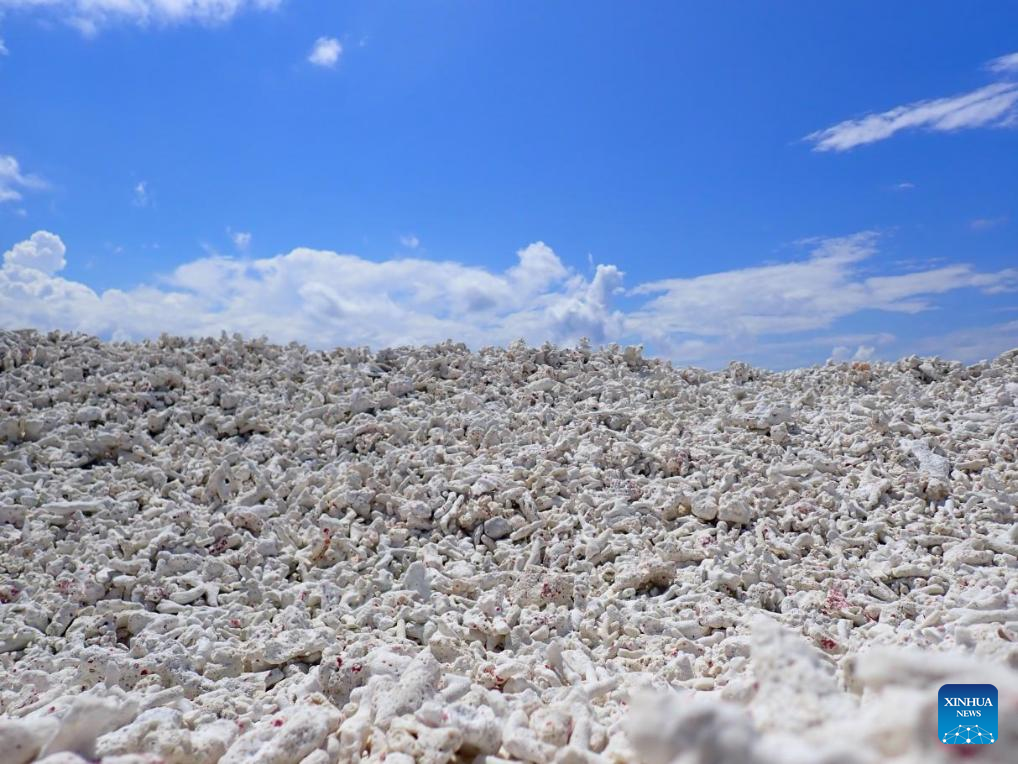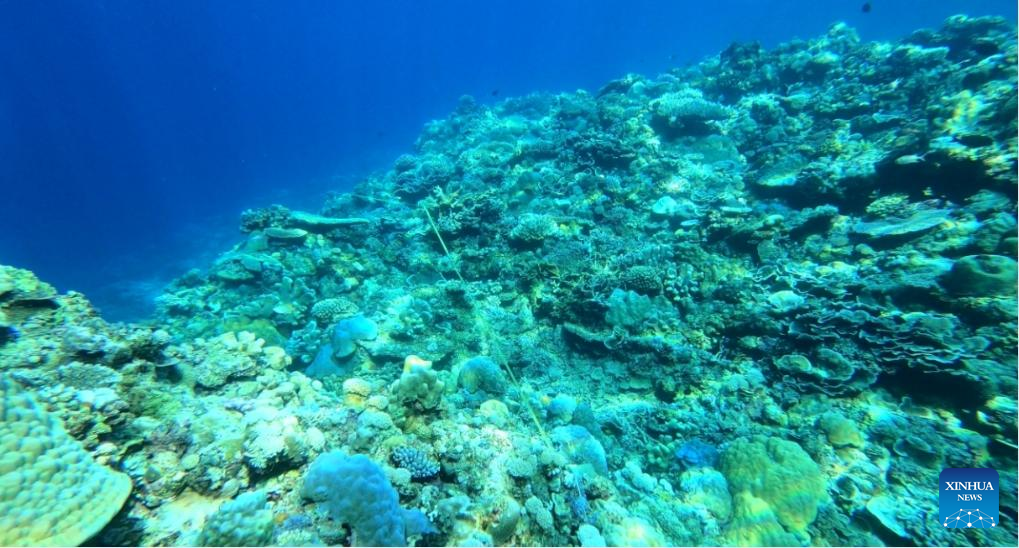
This photo taken on Aug. 30, 2024 shows the Chinese and English versions of a report named "A Survey Report on the Coral Reef Ecosystem of Xianbin Jiao" released at a press conference in Beijing, capital of China. The coral reef ecosystem at Xianbin Jiao of China's Nansha Qundao is generally healthy, said a report released on Friday, which rebutted the Philippines' false accusation of coral bleaching and death in the region. The report is compiled by the South China Sea Development Research Institute, the South China Sea Ecological Center and the South China Sea Survey Center, all affiliated to the Ministry of Natural Resources. It is China's first comprehensive review of Xianbin Jiao's ecosystem. (Xinhua/Li He)
BEIJING, Aug. 30 (Xinhua) -- The coral reef ecosystem at Xianbin Jiao of China's Nansha Qundao is generally healthy, said a report released on Friday, which rebutted the Philippines' false accusation of coral bleaching and death in the region.
From 2012 to 2024, the aggregate coverage area of reef-building corals at Xianbin Jiao reef platform within a depth of 20 meters has remained stable, with slight decline -- about 6.8 percent of the coverage area in 2012, where the cay movement has exerted some effects, according to the report, named "A Survey Report on the Coral Reef Ecosystem of Xianbin Jiao."
It is China's first comprehensive review of Xianbin Jiao's ecosystem.
The coral reef ecosystem at Xianbin Jiao is generally healthy, with a high coverage of diversified species of reef-building corals, according to the report compiled by the South China Sea Development Research Institute, the South China Sea Ecological Center and the South China Sea Survey Center, all affiliated to the Ministry of Natural Resources.
According to the report, sporadic corals have bleached due to the water temperature increasing seasonally. Common coral diseases are not detected.
The report noted that Xianbin Jiao is home to abundant species of coral reef fishes, and benthic macro-invertebrates and rare creatures were found there. The habitat quality of the reef area is generally good.
The report revealed that reef-building corals at local areas of Xianbin Jiao is threatened by hostile organisms, fleshy macroalgae and human activities.
Chinese scientists conducted the survey and evaluation of the coral reef ecosystem at Xianbin Jiao from May to July 2024, using satellite remote sensing technology and field investigations as well as historical analysis, according to the report. They analyzed how the cays have been developing and how they affected the coral reef ecosystem based on historical data.
The report noted that the institutes inversed the reef platform substrate types using high-resolution satellite remote sensing images collected from 2012 to 2024, and calculated the reef platform area within a depth of 20 meters and the coverage of various substrate types.
A total of 23 survey stations were set along the reef platform margins to cover 75 parameters across four categories, including coral communities, reef organisms, reef habitats, and human activities.
The report noted that 34 additional patrol stations were set to check the Philippines' comments that China dumped coral debris at Xianbin Jiao and caused massive coral bleaching and death in the area.
There are many ships operating in waters of Xianbin Jiao. In particular, there are amounts of Philippine ships in the lagoon without China's permission. The anchoring, mooring or fishing by those ships may affect the normal growth of corals in the area, the report noted.
Xianbin Jiao currently has six naturally formed cays and three of them are above water at high tide. All the cays at Xianbin Jiao are shingle cays comprised of large bioclastics, mainly coral debris. Reef-building corals in the debris coverage area and the surroundings have been damaged to varying degrees. This is the key area where the reef-building coral coverage area at Xianbin Jiao reduced.
Sediments on the cays at Xianbin Jiao and in the adjacent waters are highly homologous with no land-based substances found, the report added.
Analysis showed that the cays at Xianbin Jiao have sufficient materials supporting their development and formation, and their locations and geomorphology comply with natural laws. The natural movement of cays has damaged the surrounding corals, but to a limited extent, the report noted.
Analysis of satellite remote sensing images from 2012 to 2024 showed that the debris coverage areas of the six cays add up to 0.11 square kilometers, less than 0.3 percent of Xianbin Jiao reef platform.
Being part of China's Nansha Qundao, Xianbin Jiao is located to the east side of Ren'ai Jiao and under the jurisdiction of Sansha, Hainan Province.
The report stressed that China maintains indisputable sovereignty over Nansha Qundao and the adjacent waters, including Xianbin Jiao, which is supported by historical and solid legal grounds.
Efforts will be made to further intensify the survey, research, evaluation and protection for Xianbin Jiao and the adjacent waters. The negative effects exerted by intensive human activities and other external factors should be minimized to maintain the diversity, stability and sustainability of the coral reef ecosystem at Xianbin Jiao, the report noted.

This combo photo carried in a report named "A Survey Report on the Coral Reef Ecosystem of Xianbin Jiao" shows No. 4 cay in constant changes at Xianbin Jiao of China's Nansha Qundao. (Xinhua)

This photo carried in a report named "A Survey Report on the Coral Reef Ecosystem of Xianbin Jiao" shows bioclastics on a cay at Xianbin Jiao of China's Nansha Qundao. (Xinhua)

This photo carried in a report named "A Survey Report on the Coral Reef Ecosystem of Xianbin Jiao" shows Stenella longirostris swimming in the southeast waters of Xianbin Jiao of China's Nansha Qundao. (Xinhua)

This photo carried in a report named "A Survey Report on the Coral Reef Ecosystem of Xianbin Jiao" shows Sterna Sumatrana flying over the cays at Xianbin Jiao of China's Nansha Qundao. (Xinhua)

This photo carried in a report named "A Survey Report on the Coral Reef Ecosystem of Xianbin Jiao" shows the situation of coral growth at Xianbin Jiao of China's Nansha Qundao. (Xinhua)

This photo carried in a report named "A Survey Report on the Coral Reef Ecosystem of Xianbin Jiao" shows the landform of No.4 cay at Xianbin Jiao of China's Nansha Qundao. (Xinhua)

This photo carried in a report named "A Survey Report on the Coral Reef Ecosystem of Xianbin Jiao" shows coral reef fishes at Xianbin Jiao of China's Nansha Qundao. (Xinhua)

This photo carried in a report named "A Survey Report on the Coral Reef Ecosystem of Xianbin Jiao" shows an aerial view of Xianbin Jiao of China's Nansha Qundao. (Xinhua)

This photo carried in a report named "A Survey Report on the Coral Reef Ecosystem of Xianbin Jiao" shows reef-building corals in normal growth at No. 12 survey station, about 300 meters southeast of No. 4 cay at Xianbin Jiao of China's Nansha Qundao. (Xinhua)

This photo carried in a report named "A Survey Report on the Coral Reef Ecosystem of Xianbin Jiao" shows Eretmochelys imbricata, a sea turtle species, in the southeast waters of Xianbin Jiao of China's Nansha Qundao. (Xinhua)

This photo carried in a report named "A Survey Report on the Coral Reef Ecosystem of Xianbin Jiao" shows a Tridacna maxima found at the reef area of Xianbin Jiao of China's Nansha Qundao. (Xinhua)

This photo carried in a report named "A Survey Report on the Coral Reef Ecosystem of Xianbin Jiao" shows Pterois radiata, a species of coral reef fish, at Xianbin Jiao of China's Nansha Qundao. (Xinhua)

This photo carried in a report named "A Survey Report on the Coral Reef Ecosystem of Xianbin Jiao" shows a crown-of-thoms starfish in the northwest side of the reef platform at Xianbin Jiao of China's Nansha Qundao. (Xinhua)

This photo carried in a report named "A Survey Report on the Coral Reef Ecosystem of Xianbin Jiao" shows the situation of coral growth at Xianbin Jiao of China's Nansha Qundao. (Xinhua)

A press conference is held to release a report named "A Survey Report on the Coral Reef Ecosystem of Xianbin Jiao" in Beijing, capital of China, Aug. 30, 2024. (Xinhua/Li He)









